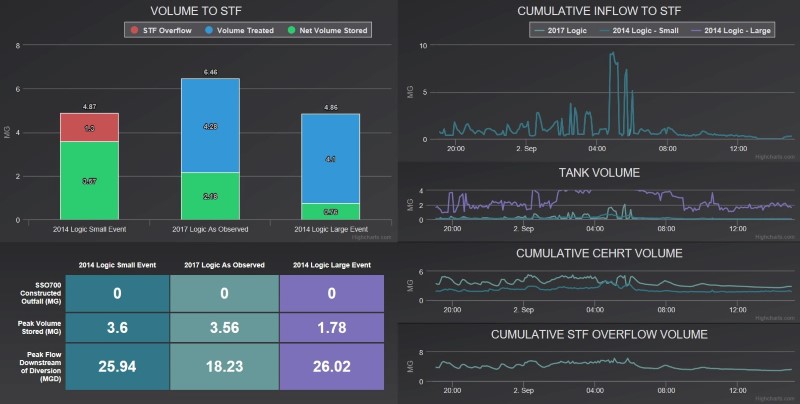Digital twin technology helps city reduce combined sewer overflow volume by 247 million gallons, saving $38 million in capital project work
Metropolitan Sewer District of Greater Cincinnati
Cincinnati OH, USA

The Metropolitan Sewer District of Greater Cincinnati (MSD) serves an Ohio population of more than 850,000 spread out across 290 square miles. Like many large cities, Cincinnati MSD operates combined and sanitary sewer systems, some of which were built more than a century ago. Whether by design, or due to infiltration and inflow of stormwater, these systems have a tendency to overflow, discharging untreated sewage into local waterways or flooding streets and basements.
Challenge
Cincinnati’s sewers discharge an average of 11.5 billion gallons of combined sewage every year into the Ohio River and its tributary streams within Cincinnati’s urban watershed.
In 2002, the EPA entered into a federal consent decree with MSD, mandating the elimination of sanitary sewer overflows and significant mitigation of combined sewer overflows into receiving waterways. Engineers estimated the cost to mitigate the sewer overflows at $3.1 billion, an unacceptable capital expense to pass along to MSD’s customers.
Recognizing the generally inadequate stormwater management capabilities of their existing combined sewer system, MSD prepared a comprehensive wet weather improvement plan. MSD recognized that full sewer separation and deep tunnel construction are massive capital investments that have very low return on investment because they create only episodic benefits during peak flow events and are single use assets with little additional community wealth creation.
Instead, MSD’s objective is to maximize existing capital assets — such as sewer interceptors, storage and treatment facilities, and pump-stations — to reduce overflows and gain system-wide benefits through advanced control logic that will optimally operate MSD’s urban watershed.
Solution
To overcome these challenges MSD partnered with Xylem to optimize the performance of their existing assets through the power of decision intelligence.
MSD and Xylem began by focusing on the Mill Creek Interceptor (MCI), a major carrier of flows through the MSD service area, and MCI’s most upstream asset, the SSO700 Storage and Treatment facility (STF). This facility, along with four additional control sites, were originally designed to reduce overflow volumes from the constructed outfall at the river. SSO700 STF has 3.6 million gallons of storage and a 10 million gallon per day tank. These assets, combined with the real time control (RTC) facilities located downstream on the MCI, provide multiple points to control sewage along the length of the interceptor.
Historically, SSO700 STF and the RTC facilities have been controlled locally without any coordination between them and other facilities, and MSD needed to implement a solution to cost-effectively increase performance and capacity utilization.
Xylem worked with MSD to implement Xylem's SSO/CSO Prediction and Prevention applications, which utilizes a combination of sensors and weather data, along with artificial intelligence, to create a real time decision support system that delivers automated, optimized control of existing assets to reduce sewage overflows, maximize storage, and maximize treatment during wet weather.
SSO-700 STF is now controlled based on real-time upstream and downstream conditions, along with real-time feedback on what’s happening at two of the downstream RTC facilities (Ross Run and Mitchell Ave). This allows MSD to harness the power of Collection System Optimization analytics when deciding whether to active or deactivate high rate treatment and when to fill or drain tanks.

"The real-time decision support provided by Xylem gives our operators the time and confidence they need to ensure we are optimizing our collection system to reduce sewer overflows during wet weather events."
Matthew Van Doren
Supervising Engineer, Metropolitan Sewer District of Greater Cincinnati
Outcome
The project was an overwhelming success – after MSD implemented the coordinated RTC program, overflow volumes were reduced by 247 million gallons annually (based on 2015 rainfall). Implementation of the control system, when compared to a capital work estimate of more than $38 million, meant a reduction in cost of more than 90% was passed on to MSD’s customers. Moreover, CSO mitigation was achieved at a price of less than $0.01/gallon.
Taken together, these approaches enabled MSD to achieve significant reductions in both the capital and operating costs of collecting and treating wastewater in compliance with environmental regulations.
Let’s see what’s possible for water.
Learn more about Xylem Vue powered by GoAigua's SSO/CSO Prediction and Prevention

Learn more about Xylem Vue powered by GoAigua's smart, end-to-end wastewater system that helps utilities optimize networks and operations at significantly lower costs.
Read Digital Twin eBook

When digital twins are coupled with advanced data science like hydroinformatics and water system expertise, utilities are empowered with the intelligence they need to make crucial decisions, earlier. Discover the steps water managers can take to adopt and maximize a digital twin, today.
Webinar: Smart Sewers 2.0 - How Cincinnati Is Delivering Next Generation Collection Systems Management

Hear how the Metropolitan Sewer District of Greater Cincinnati is delivering the next generation of collection systems management.
Take the next step to optimizing your wastewater networks
Start analyzing your wastewater networks to improve operational efficiency and reduce costs.
Learn more about Xylem Vue
Learn how Xylem Vue is redefining what's possible for water with digital solutions that empower utilities to deliver transformative outcomes to their communities.
